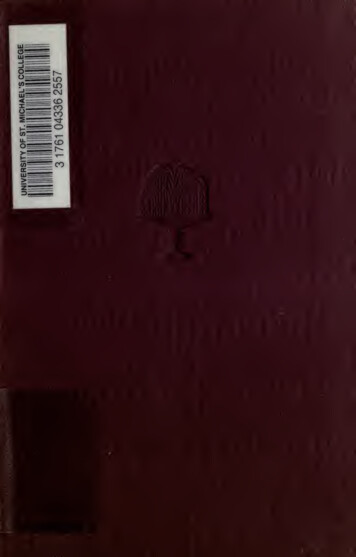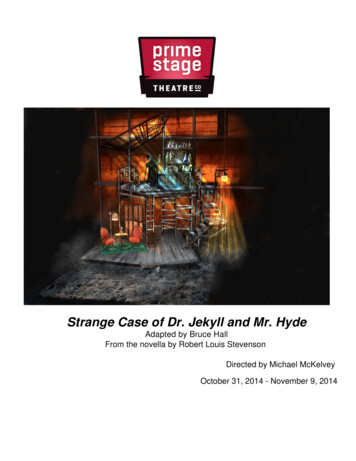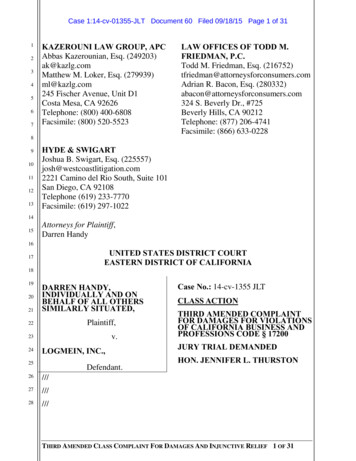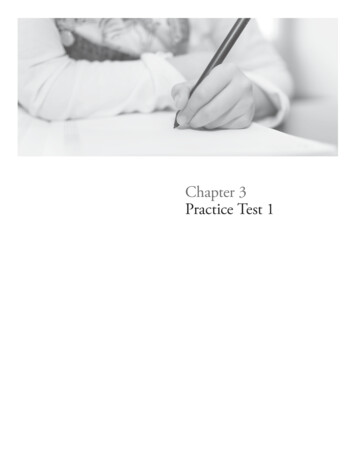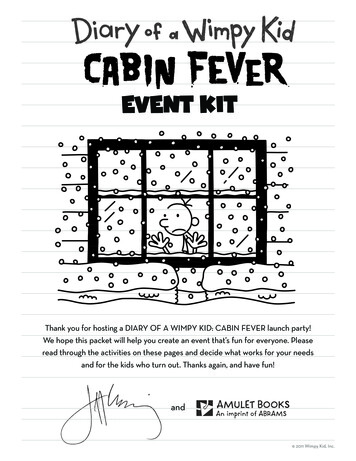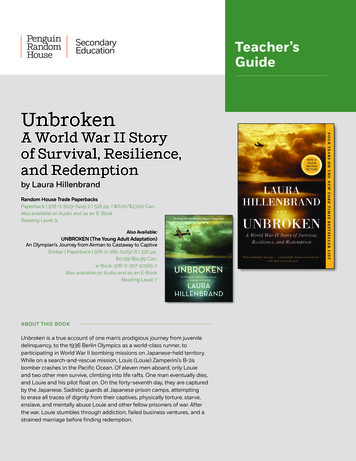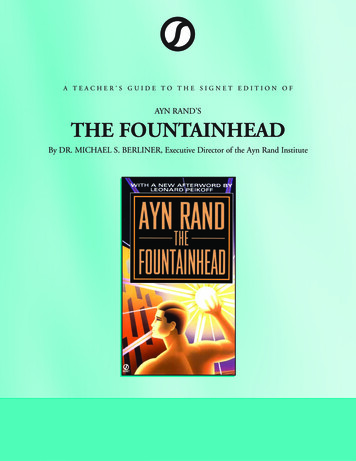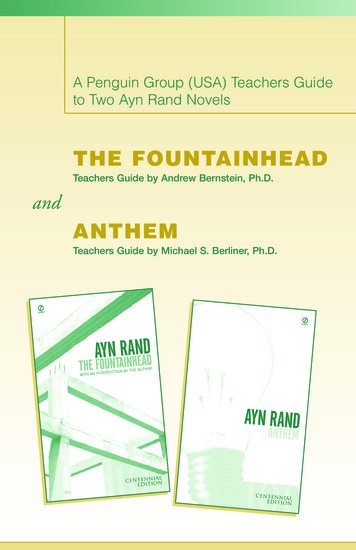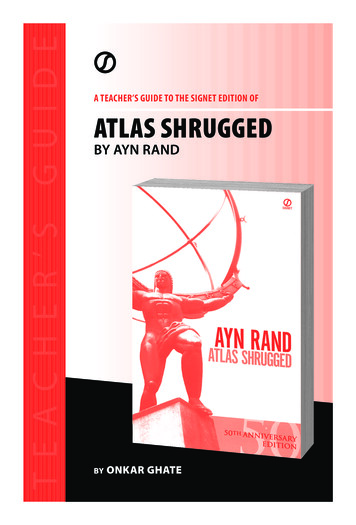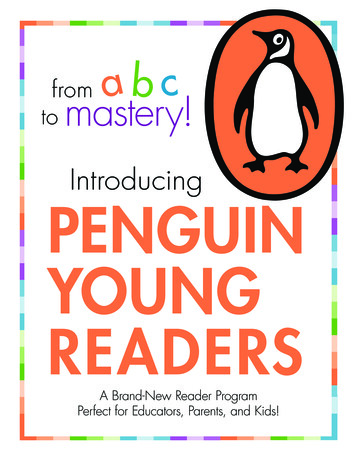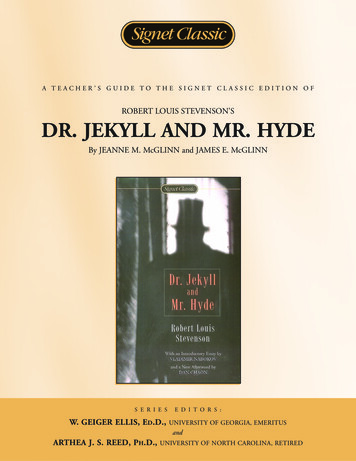
Transcription
A TEACHER’S GUIDE TO THE SIGNET CLASSIC EDITION OFROBERT LOUIS STEVENSON’SDR. JEKYLL AND MR. HYDEBy JEANNE M. McGLINN and JAMES E. McGLINNS E R I E SW. GEIGER ELLIS, ED.D.,E D I T O R S :UNIVERSITY OF GEORGIA, EMERITUSandARTHEA J. S. REED, PH.D.,UNIVERSITY OF NORTH CAROLINA, RETIRED
A Teacher’s Guide to the Signet Classic Edition of Robert Louis Stevenson’s Dr. Jekyll and Mr. Hyde2INTRODUCTIONRobert Louis Stevenson’s Dr. Jekyll and Mr. Hyde is an appropriate addition to a high school or college class in BritishLiterature or a general literature class. It is a brief work, often referred to as a novella, that offers an interesting plot, vividcharacters, elegant writing, and a provocative treatment of themes that continue to be relevant today. We encounter themystery of Jekyll and Hyde through the eyes of the mild-mannered lawyer Mr. Utterson and experience increasingsuspense with him as he tries to understand how his friend Dr. Jekyll is connected to the repulsive Mr. Hyde. The suspenseis relieved somewhat but the mystery still remains when Utterson breaks down the door to Jekyll’s laboratory and findsHyde dead on the floor with a crushed vial in his hand and “the strong smell of kernels that hung upon the air” (89).Utterson finally solves the mystery when he discovers the facts of Jekyll’s horrible experiment upon himself in the lettersleft to him by Dr. Lanyon and by Jekyll himself before he disappeared for the last time into the body and mind of Hyde.Although the modern reader may have known all along the answer to the mystery, its gradual unfolding gives a sense ofclosure and satisfaction.Dr. Jekyll and Mr. Hyde satisfies in other ways as well. Stevenson’s skillful characterizations of the separate personae ofJekyll and Hyde, and of the ultimate Victorian, Mr. Utterson, contribute to the rich texture of the novel. Also, thedescriptions of Victorian London with contrasting districts of stately homes and deteriorating buildings and deserted, fogshrouded streets reflect the degeneration of Jekyll and create an air of mystery and impending horror. And Dr. Jekyll andMr.Hyde is more than a well-crafted mystery novel. Its themes include consideration of human nature, the effects ofaddiction, and the struggle of science over the supernatural—all themes to which modern readers will respond.This guide provides activities which will involve students in analyzing the plot, appreciating the richness of the novel, andreflecting on its themes. Although Stevenson employs a clear style of writing, his vocabulary includes many wordsinfrequently encountered today. For this reason there are suggestions to help students handle the vocabulary as they readfor meaning and also profit from their exposure to these words. Teachers can choose from a wide variety of teachingactivities in order to meet their goals and the needs of their students.LIST OF CHARACTERSMr. Utterson, lawyer and friend to Dr. JekyllMr. Richard Enfield, a distant cousin to Mr. UttersonDr. Henry Jekyll, doctorEdward Hyde, heir to Jekyll’s fortune in the event of his “disappearance or unexplained absence for any period exceedingthree calendar months”Dr. Lanyon, friend to both Utterson and Dr. JekyllPoole, Butler to Dr. JekyllSYNOPSIS OF THE NOVELCHAPTER 1: STORY OF THE DOOROne Sunday evening Mr. Utterson, a lawyer, and his friend Mr. Richard Enfield are taking their weekly stroll when theychance to walk down a side street in a busy part of London. On recognizing the neighborhood and seeing a particularlyshabby door, with neither a bell nor knocker, Enfield remembers an event that he had witnessed there one early wintermorning. He tells Utterson “a very odd story.” He was just passing by when he saw a man run into and knock down ayoung girl when their paths crossed at the corner. The horrible thing is that the man just kept on walking, right over thescreaming girl. Enfield was so upset that he ran after the man, a Mr. Hyde, and brought him back to the spot where thegirl was lying on the pavement. Although the girl was not hurt, her family and the people who had gathered took such adislike to the man’s appearance that they began to threaten him. In order to appease them, Hyde agreed to pay a fine of100 pounds. He went through this particular door to get some cash and a check, signed by another man, an upstandingcitizen. Utterson asks if Enfield has been exactly precise in the details of the story because he has heard of this Mr. Hyde.He knows that this door is connected to the home of his friend and client Dr. Jekyll.
A Teacher’s Guide to the Signet Classic Edition of Robert Louis Stevenson’s Dr. Jekyll and Mr. Hyde3CHAPTER 2: SEARCH FOR MR. HYDEUpon returning to his home, Mr. Utterson retrieves the will of Dr. Jekyll from his safe. It stipulates that all of his estateis to pass into the hands of his friend, Edward Hyde, upon his death or disappearance for a period of three months. Mr.Utterson does not like the terms of the will and begins to fear that Jekyll is being blackmailed.He visits Dr. Lanyon, another mutual friend, to inquire if he has met Hyde. That night he cannot sleep as he imagines theworst about Hyde. He decides he has to meet Hyde in order to clear up the mystery. From that day he takes a post in thestreet to catch Mr. Hyde coming or going from the house. One evening his patience is rewarded, and he accosts Mr. Hyde.After this encounter, Utterson tries to understand why Hyde creates such an effect of fear, loathing, and disgust. He fearsfor his friend and decides to check on him. Utterson questions the butler about the comings and goings of Hyde. He’stold that Hyde is never on this side of the house; he only uses the laboratory. Utterson leaves for home with a heavy heart.He wonders what Jekyll has done that would account for his relationship with Hyde.CHAPTER 3: DR. JEKYLL WAS QUITE AT EASEA few weeks later Dr. Jekyll hosts a dinner party for several friends, including Utterson. After the other guests leave,Utterson questions Jekyll about the terms of his will. Utterson never “approved” of this will, and lets Jekyll know that hehas been “learning something” about Hyde, whom he describes as “abominable.” Jekyll protests that Utterson does notunderstand his strange situation and assures him that he can get rid of Hyde whenever he chooses. Jekyll also requests thatif anything should happen to him, Utterson will take care of Hyde, make sure his rights are protected. Utterson agreeseven though he avows that he will never like the man.CHAPTER 4: THE CAREW MURDER CASENearly a year later London is shocked by the vicious murder of Sir Danvers Carew. A maidservant who chanced to begazing at the full moon and the lane below her window witnessed the attack. She saw an aged man inquire directions fromanother smaller gentleman whom she recognized as a Mr. Hyde who had once visited her master. Suddenly she saw Mr.Hyde blaze out “in a great flame of anger,” raise his cane, and begin to beat the older man. He clubbed him to the groundand continued to beat him as he lay in the street.The police ask Utterson to identify the body because the victim was carrying a letter addressed to him. Utterson recognizesthe stick used in the murder as one he had given to Jekyll years ago. He tells the police he can lead them to the home ofthe murderer. When they arrive there, the maid tells them Hyde had already left earlier that morning. Utterson andInspector Newcomen of Scotland Yard inspect Hyde’s room, which has been ransacked for a hasty departure. Theinspector thinks that it will be an easy matter to capture Hyde since he is sure to go to the bank for money. He can alsodistribute handbills with his description. However, the few persons who have seen him cannot agree on the particulars.The only thing they can agree on is that Hyde left them with a sense of “unexpressed deformity.”CHAPTER 5: INCIDENT OF THE LETTERLater that afternoon Utterson visits Dr. Jekyll and is admitted into his private study. He finds Jekyll looking deathly pale andsick. When Utterson asks Jekyll if he is concealing Hyde, Jekyll promises that Hyde has gone into hiding and will not be seenagain in this world. The lawyer hopes that Jekyll is right since a trial for murder could bring scandal to his client’s name.Ostensibly seeking Utterson’s professional advice, Jekyll shows him a letter he has received from Hyde saying he has ameans of escape. Jekyll allows Utterson to think that it was Hyde who dictated the terms of Jekyll’s will that were sofavorable to Hyde. Utterson agrees to safeguard the letter for his client. However, as Utterson is leaving, he learns that noletters have been delivered that morning. He suspects that Hyde wrote the letter in Jekyll’s study and finds it difficult todecide what to do with it. He seeks the advice of his clerk Mr. Guest, who had often visited Jekyll and is an expert onhandwriting. Guest compares the letter to an invitation Utterson receives from Jekyll as they are talking. He concludes thatthe two hands are remarkably similar, having only a different slant. Utterson suspects that Jekyll forget the letter for Hyde.
A Teacher’s Guide to the Signet Classic Edition of Robert Louis Stevenson’s Dr. Jekyll and Mr. Hyde4CHAPTER 6: REMARKABLE INCIDENT OF DR. LANYONAlthough a sizeable reward is offered for the apprehension of Mr. Hyde, he has disappeared as if he never existed. Dr.Jekyll comes out of seclusion and for almost two months socializes with his friends as in the old days. But one day, andevery day thereafter, his door is shut to Mr. Utterson. Lacking companionship, Utterson visits Dr. Lanyon, only to findhim totally changed physically. He seems to have suffered some shock, “some deep-seated terror of the mind.” Lanyonconfides that he will never recover and is resigned to death. When Utterson mentions Jekyll’s name, the doctor becomesangry. He tells Utterson that one day he may learn the truth. Upon reaching home that evening Utterson writes to Jekyllasking why he has cut himself off from his friends. Jekyll’s reply is that he intends to live in seclusion and that he mustsuffer for the danger he has brought upon himself.Within a few weeks Lanyon dies and Utterson receives an envelope from his friend with instructions not to open it untilthe death or disappearance of Jekyll. Resisting the impulse to get to the bottom of the mystery, Utterson files the letteraway. He finds that his desire to see Jekyll waning following these sad events.CHAPTER 7: INCIDENT AT THE WINDOWShortly afterwards, Utterson and Enfield are again going for a Sunday stroll and chance to pass by the same doorassociated with the story of Mr. Hyde. They decide to step into the courtyard to look for their friend. Jekyll is sitting ata window, looking like a prisoner. When they call to him to join them, he says he cannot but will visit with them fromhis window. Suddenly Jekyll utters a cry of terror and slams the window shut. The two friends leave instantly but theyhave seen something that makes them fear for Dr. Jekyll.CHAPTER 8: THE LAST NIGHTOne evening Poole arrives at Mr. Utterson’s home, saying that he fears there has been foul play. He begs Utterson toaccompany him to check on Dr. Jekyll. Arriving at the house, Utterson finds the frightened servants huddled together inthe entry hall.Poole and Utterson go to the door of Jekyll’s study where Poole announces that Utterson has come to visit. The personwithin answers that he cannot see anyone. Then Poole confers with Utterson saying the voice they have heard isn’t thevoice of his master. Poole believes his master was killed over eight days ago when they heard him cry out. All week longwhoever is in the study has been sending out orders to find a particular drug. Although the handwriting appears to bethat of Dr. Jekyll, Poole says it doesn’t matter because he has seen the person and it isn’t his master.Acting on Poole’s conviction that murder has been done, Utterson decides they must break down the door and investigate.They both confess they suspect that Mr. Hyde is within the study. When Utterson demands to see Jekyll at the door, theperson within cries out for mercy. But Utterson and Poole break down the door with an ax. Within they find the body ofHyde, twitching in convulsions from the poison he has taken. They realize that they are too late and all they can do nowis look for the body of Jekyll. However, the search is fruitless. When they reexamine the study, they find an envelopeaddressed to Utterson with a note from Jekyll directing him to read the narrative left by Lanyon. Utterson departs for hisstudy to read through all the documents.CHAPTER 9: DR. LANYON’S NARRATIVELanyon describes a letter he received from Dr. Jekyll. He is instructed to go to Jekyll’s study, to break the locks, and tosecure a particular drawer and its contents. A man will come to his consulting room at midnight. Lanyon carries out allthe details of the letter and admits a small and muscular man who creates a sensation of “disgusted curiosity.” Immediatelythe man begins to prepare a compound from the contents of the drawer. When it is ready, the man asks Lanyon if hewishes to let him go or to learn what will happen when he drinks the compound. Lanyon declares that he has gone toofar not to see what will happen. Thereupon the man drinks the potion and begins to change and assume the form ofHenry Jekyll. From that moment Lanyon feels his reason shaken and a deadly terror invades his thoughts.He knows he will not recover from this shock. He has seen the creature change from Hyde to Jekyll.
A Teacher’s Guide to the Signet Classic Edition of Robert Louis Stevenson’s Dr. Jekyll and Mr. Hyde5CHAPTER 10: HENRY JEKYLL’S FULL STATEMENT OF THE CASEThis last chapter is a full testament written by Jekyll concerning his history and his character. Jekyll describes himself asa proud man who wanted a reputation as a serious person. Early on he hid his natural high spirits and developed a doublecharacter. His scientific studies focused on the mystical and transcendental as he searched out these aspects of man,especially in the moral dimension. He wanted to learn how these two sides could be disconnected. At the same time hewas studying drugs and discovered a potion that could transform his flesh and turn him into a creature that representedhis baser nature. When he tries the drug on himself, he feels himself to be extremely wicked but at the time he wasexhilarated by this sensation. He begins to live this dual life, one as the respectable gentleman and the other as a personwho gives into every impulse. Jekyll continues to metamorphose back and forth between his two halves until one day thereversal occurs spontaneously. He realizes that the evil side of his nature is growing and is in danger of taking control ofhis life. He tries to resist the temptation but once again he gives in. This time he kills Sir Carew. He is penitent and triesto maintain a good and sober life until he forgets his terror. Now his evil side begins to take over even without the drug.He must use stronger and stronger doses of the potion to return to his original self. When he runs out of the salt he usesin the compound, he finds that the fresh supply he orders does not have the power to transform him.As he writes this testament he knows he has limited time before his evil nature takes over. He wonders if Hyde will dieon the scaffold or commit suicide. This is the end of the unhappy life of Henry Jekyll.TEACHING DR. JEKYLL AND MR. HYDEPREREADING ACTIVITIESThese activities are designed to build students' background knowledge about the plot, characters, and themes. Choose theactivities that best fit the themes you plan to teach or your goals for students’ learning. (Note: Consult other Teacher'sGuides to Signet Classic novels; they contain many ideas that can be adapted to prepare students to read this novel.)I. BUILDING BACKGROUND KNOWLEDGEProblem SituationThis activity acquaints students with important ideas in Dr. Jekyll and Mr. Hyde by getting them to think about addiction,physiological and psychological changes that accompany the use of drugs or other addictive behaviors, and theresponsibility of individuals to address destructive behaviors they observe in others. Students read the problem situation,respond in writing, and compare their responses in small groups or pairs. Have students discuss, clarify, and probe themain responses of the groups.You have recently become worried about one of your close friends. In your mind he has always been a good person. Heis kind to everyone and is recognized as a school leader. He has worked as an ESL tutor for some of the younger studentsand has started a recycling program in the school. He is good at science and talks of going to medical school someday.The cause of your worry for your friend is his secret fondness for drinking. He has used his chemistry skills to learn howto make homemade beer. Since his parents wouldn’t approve, he makes and stores the beer in an old shed behind his housewhich his parents never use. Your friend started off drinking only a beer or two but lately he is downing a six-pack anevening, and he is changing. He becomes uninhibited and mean. He drives recklessly, and when you tell him he shouldn’tdrink and drive he gets mad at you. Once he pushed you and told you what he did was none of your business. You fearthat your friend is heading for serious trouble, and you wonder what you should do about it.Free write about what you think might happen to your friend if he continues on this path. Also write down some ideasabout what steps you might take to help him change his behavior. After you have written for about five minutes, join apartner and discuss your ideas.Guided Imagery1.In this exercise students listen to a detailed description of the setting (with excerpts taken from the novel, pp. 38-39) andthen are encouraged to record the impressions provoked by the imagery. They can compare their descriptions and discussthe following ideas: how a writer builds expectations in readers, what happens when expectations are met or not met inthe story, how judgments of character are based on outward appearances. Have students relax, close their eyes, and listenfor the images of the setting as you slowly read the guided imagery to them.
A Teacher’s Guide to the Signet Classic Edition of Robert Louis Stevenson’s Dr. Jekyll and Mr. Hyde6You are out for a Sunday walk. It is 1865, and you are in a busy quarter of London in a drab and dingy part of town.But you walk down a brightly decorated side street that is lined with shops on both sides. The storefronts are veryattractive—they stand along the street with an air of invitation, like rows of smiling saleswomen. Even on Sunday, whenit veils its more florid charms and lies comparatively empty of passage, the street shines out in contrast to its dingyneighborhood, like a fire in a forest; and with its freshly painted shutters, well-polished brasses, and general cleanlinessand gaiety of note, instantly catches and pleases your eye.Two doors from one corner, the line of shops is broken by the entry of a courtyard; and just at that point, a certain sinisterblock of building thrusts forward its gable on the street. It is two stories high; shows no window, nothing but a door onthe lower story and a blind forehead of discolored wall on the upper story; and bears in every feature the marks ofprolonged and sordid negligence. The door, which is equipped with neither bell nor knocker, is blistered and stained.Tramps have slouched into the recess and have struck matches on the panel. You stare at the sinister looking door andwonder who could be living behind it. A cold chill and feeling of dread creeps upon you.Then, before your eyes, the door slowly opens and a man emerges from it. He gives you a long and menacing look. Inspite of your fear, you look closely at the man. How does the man look? See his eyes, his mouth, his face, and his hair.How is he standing? What is he wearing? What does he do?Now slowly open your eyes and return to this classroom. Take five minutes to quickly write a description of the man yousaw emerge from the door. What does he look like? Describe the features of his face and his general appearance, andthen write a sentence or two about what the man does when he sees you. You will share your descriptions with a partner,and then discuss as a class.2.As an alternative imagery exercise, have students read the description of the shop-filled street and the sinister building onpp. 38-39 of the novel. Then have them draw a picture of the building and door. After they share their pictures with apartner, discuss as a class the features they noticed and what kind of mood or expectation Stevenson evokes in the readerwith this description.Vocabulary StudyStevenson’s novel was written in 1886 and so uses diction and vocabulary that students encounter less frequently today.Encourage the use of context for figuring out the meaning of words and text by use of a cloze passage.First have students go through the passage below guessing at a word that best fits the context. Then ask students whatthey learned about Mr. Utterson. How does he look? What is his profession? What is his personality? What are hisinclinations? After the discussion, read the first page of the novel while students follow in their books. Ask students whatwords were eliminated. Were they able to substitute words that fit the context? Did they get the overall meaning of thepassage without reading every word? Explain to students that this novel, although short, is written ina formal diction of the 19th century. They should read for the overall meaning, not worrying about the definition of everyword. They have shown through their predictions that they can get the main idea without knowing the meaning of eachword. Using context clues will enable them to enjoy reading a rich and complex psychological study.Mr. Utterson the lawyer was a man of a rugged that was never lighted by a smile; cold, and embarrassed in; backward in sentiment; lean, long, dusty, dreary and yet somehow loveable. At friendly meetings, and when thewine was to his taste, something human from his eye; something indeed which never found its way into histalk, but which spoke not only in these silent symbols of the after-dinner face, but more often and loudly in the acts ofhis life. He was with himself; drank gin when he was alone, to a taste for vintages; and though he enjoyedthe theater, had not crossed the doors of one for twenty years. But he had an approved for others; sometimeswondering, almost with envy, at the high pressure of spirits involved in their misdeeds; and in any extremity inclined tohelp rather than to reprove.
A Teacher’s Guide to the Signet Classic Edition of Robert Louis Stevenson’s Dr. Jekyll and Mr. Hyde7Internet ResourcesBelow are a variety of research and reading activities that use Internet resources to build students’ background knowledge.1.2.Dr. Jekyll and Mr. Hyde was a precursor to the detective novel, which formally began with the first Sherlock Holmes novelpublished in 1887. Law enforcement and detective work were in their beginning stages. If your students are mature usersof the Internet and are able to perform unrestricted searches, assign the following topics to pairs of students to investigateon the Internet: The “Black Museum” of Scotland Yard Alphonse Bertillon (identification of criminals through body measurements) Francis Galton (finger printing)Awaken student interest in the novel by having them look at a cover of the Jekyll and Hyde video game at:http://www.dbline.it/shtm/cdgi1710.htmAsk students to first brainstorm on paper their impressions of what the Jekyll and Hyde images suggest about the twopersonalities. Then have students share these with the whole class. As a related post-reading project, have students returnto this image and work in pairs to design a video game that reflects the plot of the novel. Have them write a descriptionof the video game and draw a series of three images showing the plot line of the game.3.Have students steep themselves in Victorian London by first scanning the pictures s.htmlThen have students individually choose one of the pictures, write a brief description of what they see and what they inferfrom the picture about Victorian life.4.If you have access to a computer lab with sufficient stations or wireless laptop computers connected to the Internet, youcan build upon student interests by assigning them to work in groups of two or three on a Victorian London Scrapbook.In the computer lab, have students go to the London Index at: e students follow these directions:5. Skim some of the sites in each of the four topics: Buildings and Institutions, Law and Order, Commerce, and Events.Decide which of the topics your group would like to explore. Have each member of your group explore different sites under the topic by reading text and looking at the pictures. Have each member of the group capture at least two images they think are interesting and save the images on a floppy disk. Then get together with your other group members and prepare a slide show on PowerPoint composed of the picturesyour group members have chosen. Present the slide show to the class. As you show each slide under your topic, have the group member who collectedthe picture identify what it is and why it is interesting and what it tells about Victorian London. Each group presentation will be limited to five minutes. Group grades will be assessed on the basis of the overallorganization and clarity of the presentation. Individual grades, using the same criteria, will be assigned to studentsbased on their presentation of their slides.To give students a view of a seamier section of Victorian London with the attractions that might have appealed to thesecret side of Dr. Jekyll, have them read the newspaper article of 1862 titled “Whitechapel Road on a Saturday Night,”located at: http://www.casebook.org/victorian london/whitesat.htmlAfter they read the article, use levels of questions to discuss it. First ask students to identify the attractions that were offeredin this part of town. Then have them compare these attractions to entertainment in a big city today. Next ask students todiscuss why people are attracted by these kinds of entertainments, what impact they may have on society, and whetherthe city government should exercise a role in controlling or policing the entertainment sites or an individual’s choices.
A Teacher’s Guide to the Signet Classic Edition of Robert Louis Stevenson’s Dr. Jekyll and Mr. Hyde6.8To build students’ background knowledge about the work of the doctors who are the main characters in the novel, use acomputer projector to have the class as a group read and discuss: an overview of Victorian medicine at: t.html a description of health care professionals of the time at: e.htmlStudying Works of ArtNineteenth century Romantic artists emphasized feeling, emotion, and intuition in their choice of subjects and artisticstyle. They were interested in all aspects of fantasy: imagination, dreams, nightmares, the infernal, and the macabre. Theyexplored what happens when the human mind goes into the darker side of consciousness or when reason is asleep. Forexample, the Romantic artist, Theodore Gericault, was interested in the irrational states of the human mind and the ideathat the mind affected the physical appearance of a person. He created many studies of the mentally ill and criminallyinsane.Have students study paintings of one or more of these artists, depending on availability and time. Paintings can be foundon the Internet or in illustrated art books. Students can first study the painting with a partner, listing details, anddescribing the painting as fully as possible. Then have the students write a poem as if they are within the painting. Theycan assume the persona of any person or object in the painting. Share these poems in small groups and post the poemswith the paintings.Works of art that examine states of mind: The Nightmare 1781 by Henry Fuseli The Sleep of Reason Produces Monsters 1798 by Francisco Goya Saturn Devouring One of His Children 1819-1823 by Francisco Goya Insane Woman (Envy) 1822-1823 by Theodore GericaultII. INITIAL EXPLORATION OF THEMESA careful reading of Dr. Jekyll and Mr. Hyde can reveal multiple levels of meaning. At one level it is a story about a madscientist gone wrong, at another level it is a reflection on human nature. Students can be supported in reading for differentlevels of meaning through activities that help them think about the themes in the novel before they begin to read. Byestablishing an atmosphere of mutual questioning and seeking insight at the beginning of the unit, students will beencouraged to openly question and discuss their attempts at developing understanding with other members of the class.Dual Nature or Split Personality1.In order to explore how persons can engage in both positive and negative behaviors, students can free write about a timewhen they showed kindness to an animal or another person and then about a time when they were cruel or unkind. Afterthey have written, students should privately read their journals to analyze why they might act in these opposite ways atdifferent times. With the class, students should analyze the causes of different types of behaviors. What causes a personto act in such radically opposite ways and what does this suggest about human personality or human nature?2.Many religions use the concept of dual nature to explain the struggle within a person to choose between good and evil.In the Hebrew Bible evil is pe
DR. JEKYLL AND MR. HYDE By JEANNE M. McGLINN and JAMES E. McGLINN. INTRODUCTION Robert Louis Stevenson’s Dr. Jekyll and Mr. Hyde is an appropriate addition to a high school or college class in British Literature or a general literature class. It is a brief work, often referre
